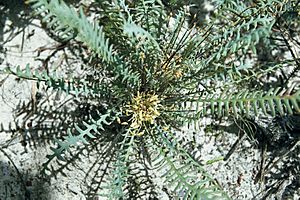Dwarf dryandra facts for kids
Quick facts for kids Dwarf dryandra |
|
|---|---|
 |
|
| Conservation status | |
| Scientific classification | |
| Genus: |
Banksia
|
| Species: |
nana
|
| Synonyms | |
|
|
The Dwarf Dryandra, also known as Banksia nana, is a special type of shrub. It only grows in a small part of Western Australia. This plant has stems that grow underground. Its leaves have sharp, pointy parts, and its flowers are pale green or yellow. After flowering, it grows egg-shaped seed pods called follicles.
Contents
What Does Dwarf Dryandra Look Like?
The Dwarf Dryandra is a shrub with short, hairy stems that grow underground. It also has a small lignotuber, which is a woody swelling at the base of the plant. This helps the plant survive fires.
Leaves and Flowers
The leaves of the Dwarf Dryandra are long and narrow, about 40 to 190 millimeters (about 1.5 to 7.5 inches) long. They are 10 to 24 millimeters (about 0.4 to 0.9 inches) wide. Each leaf has between ten and thirty-five sharp, pointy parts on each side.
The plant produces between twelve and seventeen pale green or yellow flowers. These flowers grow in a cluster at the end of the branches. The flowers appear in October. After the flowers, the plant grows seed pods called follicles. These pods are shaped like broad eggs and are about 13 to 14 millimeters (about 0.5 inches) long.
How Dwarf Dryandra Got Its Name
This plant was first officially described in 1855 by a scientist named Carl Meissner. He named it Dryandra nana. He published his description in a journal called Hooker's Journal of Botany and Kew Garden Miscellany. The plants he studied were collected by another botanist, James Drummond.
Meaning of the Name
The second part of its name, nana, is a Latin word. It means "dwarf," which fits because this plant is quite small. Later, in 2007, two scientists, Austin Mast and Kevin Thiele, moved all the plants from the Dryandra group into the Banksia group. So, the plant's name changed to Banksia nana.
Where Dwarf Dryandra Grows
The Dwarf Dryandra grows in a type of shrubland called kwongan. This plant prefers low hills near a town called Badgingarra. This area is part of the Geraldton Sandplains and Swan Coastal Plain regions in Western Australia.
Protecting Dwarf Dryandra
The Government of Western Australia's Department of Parks and Wildlife has given this banksia a special classification. It is listed as "Priority Three".
What "Priority Three" Means
This classification means that the Dwarf Dryandra is not very well known. It has only been found in a few places. However, it is not currently in immediate danger of disappearing. Scientists keep an eye on these plants to make sure they stay safe.


